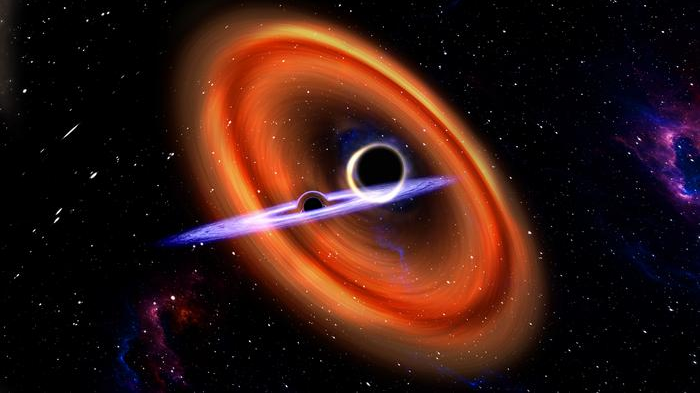Scientists have “heard” the symphony of two newborn black holes, each created when their respective parent black holes collided and merged. In fact, one of those collisions was the first of its kind.
The detection of small black holes and information about the four parents. black holes that forged them was courtesy of ripples in space-time, or gravitational wavescaused by the violent cosmic events that gave rise to them. These waves were recorded by the LIGO (Laser Interferometer Gravitational Wave Observatory), Virgo Gravitational Wave Detectors and KAGRA (Kamioka Gravitational Wave Detector).
Less than a month after this groundbreaking detection, on November 11, 2024, gravitational wave instruments “heard” another newborn black hole screaming after the violent collision of its progenitors. This signal, GW241110, originated from a collision between black holes with 16 and eight times the mass of the Sun and occurred about 2.4 billion light years away. This signal revealed that one of the black holes involved was spinning in the opposite direction to its orbit around the other black hole, the first time such a feature has been observed in mergers. binary black holes.
“Each new detection provides important information about the universe, reminding us that each observed merger is both an astrophysical discovery but also an invaluable laboratory for investigating the fundamental laws of physics,” said Carl-Johan Haster, assistant professor of astrophysics at the University of Nevada, Las Vegas (UNLV). said in a statement. “Binaries like these had been predicted from previous observations, but this is the first direct evidence of their existence.”
Both events indicate the existence of so-called second generation black holes.
“GW241011 and GW241110 are among the most novel events among the several hundred that the LIGO-Virgo-KAGRA network has observed,” Stephen Fairhurst, a spokesperson for the LIGO Collaboration and a professor at Cardiff University, said in the statement. “Since both events have a black hole that is significantly more massive than the other and spinning rapidly, they provide tantalizing evidence that these black holes formed from previous black hole mergers.”
Black holes: the second generation
The idea that the detected black holes are second generation arises from the difference in size between the largest black holes and their smaller companions in the two mergers. The tiniest black holes appear to have had almost half the mass of their companions. The opposite orbital orientation of the spin of the largest black hole in the merger that produced the GW241110 signal is also evidence that an earlier merger produced that dominant black hole.
The process of a black hole growing by collision after collision is known as “hierarchical fusion.” This is thought to occur in densely populated regions such as star clusters, where black holes are more likely to meet and merge again and again, resulting in larger black holes.

GW241011 offers scientists the opportunity to probe the limits of Albert Einstein’s 1915 theory of gravity. general relativitywhere the concepts of black holes and gravitational waves arose.
For example, the rapid rotation of the black hole involved in this particular merger warps the object and leaves a unique impression on the gravitational waves it emits. This means that this event can be compared to general relativity and the predictions that physicist Roy Kerr made using Einstein’s theory of rotating black holes. The black holes in GW241011 fit Kerr’s solution to general relativity, the study team explains, helping to verify it, as well as Einstein’s own masterpiece theory under extreme circumstances. This includes confirming for the third time within a gravitational wave signal (GW241011) the “hum” of a higher harmonic, similar to the overtones of musical instruments.
The LIGO-Virgo-KAGRA collaboration also believes that these gravitational wave signals could be key to unlocking something predicted but never before seen: something outside the limits of general relativity.
Additionally, the mergers of two black holes behind these signals have the potential to reveal more about an unrelated scientific field: particle physics.
Scientists can use rapidly spinning black holes to test the supposed existence of ultralight bosons, or particles that exist beyond the standard model of particle physics. If they existed, ultralight bosons should extract rotational energy from rotating black holes. How much energy these particles extract and how much they slow down black holes depends on their mass.
The revelation that the merger progenitor black hole behind GW241011 is still spinning at a rapid rate after millions (or even billions) of years since the merger that created it appears to rule out a variety of ultralight boson masses.

“The detection and inspection of these two events demonstrate how important it is to operate our detectors in synergy and strive to improve their sensitivities,” said Francesco Pannarale, co-chair of the Observational Sciences Division of the LIGO-Virgo-KAGRA Collaborations and professor at the Sapienza University of Rome. “The LIGO and Virgo instruments taught us even more about how black hole binaries can form in our universe, as well as the fundamental physics that governs them at their very core.
“By updating our instruments, we will be able to delve deeper into these and other aspects with greater precision in our measurements.”
The team’s research was published Tuesday (Oct. 28) in the Letters from astrophysical journals.



